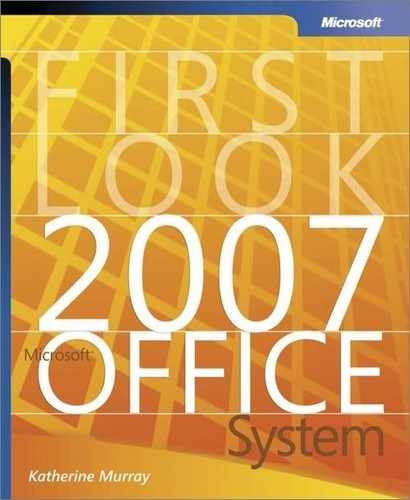A Look at the New User Interface
The new Office Access 2007 window is designed so that you can quickly select and work with the tables, forms, reports, and queries in your database. New design features help you get a quick sense of important data items and provide you with the tools you need to complete the task at hand.
Choosing Your View
You need a set of tools to work with information in a meaningful way. You need to be able to enter information quickly in Datasheet View; display information items in such a way that others can respond easily by using Forms View; create and modify that form for others to use (that’s Design View); and set up how the information will look in a report in Layout View. Now you can switch among all those views easily when you’re working with your information by clicking the View button in the Home tab (see Figure 9-3).
Figure 9-3. The View button in the Home tab enables you to display different views easily.

Tip
|
| You can also change the view by clicking the view control you want to use in the lower-right corner of the Office Access 2007 window. |
New Command Tabs
You’ll notice right away that the tabs in Office Access 2007 are new and intuitive. Now the command tabs follow a simplified progression: Home, Create, External Data, and Database Tools. Here’s what you’ll find in the various menus:
The Home tab contains the command sets you will use to change views; and add, format, filter, and search records in your database.
The Create tab gives you the tools you need to design and add tables, Office SharePoint 2007 lists, forms, reports, queries, and macros.
The External Data tab (see Figure 9-4) provides tools for importing information from and exporting to Office Access 2007, Office Excel 2007, text files, XML files and more. You’ll also find tools for saving as in XPS format, gathering information via e-mail, and synchronizing your information with Office SharePoint 2007 lists.
Figure 9-4. The External Data tab displays all your import, export, and data collection tools in one place.

The Database Tools tab contains more advanced tools for working with macros; displaying relationships and dependencies; and analyzing, managing, and synchronizing your information.
Navigation Pane
A new Navigation Pane stretches along the left edge of the database window in all views in Office Access 2007. When you open the Navigation Pane by clicking the right arrows, it fills the left column of the database window, giving you quick access to your tables, queries, reports, and more (see Figure 9-5). The new Navigation Pane replaces the Database window and the Switchboard function in previous versions of Office Access. (Note that switchboards you created as part of custom applications in previous versions should continue to work in Office Access 2007.)
Figure 9-5. The Navigation Pane displays all the tables, forms, reports, queries, and macros you use to work with the information in your database.

The Navigation Pane groups your database objects so that you can find them easily. For example, if you have a table for your customer data and a form that enables you to add to and modify the information in that table, both items will be grouped together in the Navigation Pane.
Home Window
Depending on the template you select for your database, you might see the Home window when you open a database application. The Home window offers you quick-look information, providing a summary of the data in the current database. Charts spotlight important data trends; lists related to the content and focus of the application (such as Active Orders and Inventory to Reorder, shown in Figure 9-6) appear in the Home window.
Tabbed Windows
When you open tables, queries, reports, and forms by double-clicking them in the Navigation Pane, they open in the work area (see Figure 9-7). Each item you open becomes a tabbed window in the display. You can move among the different items by simply clicking the tabs. When you want to close a view, right-click a tab and choose Close.
Figure 9-7. Tabbed windows enable you to display multiple elements and move among them easily.


